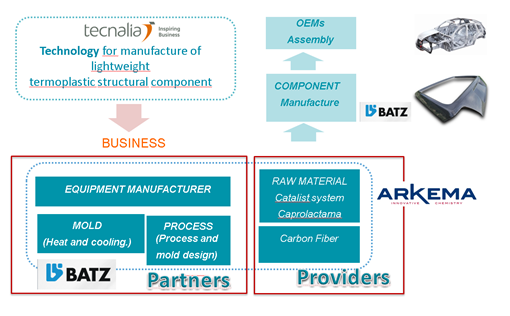Project duration: 1 January 2016 – 31 December 2018
Objective
Continuous fiber reinforced plastic can achieve weight reductions of 60% compare with steel but its introduction in the automotive sector remains limited to niche luxury and premium concepts (small series) due mainly to the cycle times, the production costs and the price of raw materials.
The project intent to address this problem scaling to a medium-high volume automobile condition a technology for processing thermoplastic structural composites that has shown its capability to manufacture the automotive structural part with lower costs.
Besides the cost issue, the recyclability is the other big limitation for the use of continuous fiber reinforced plastic: thermoplastics offers this advantage together with high impact resistant and good weldability.
The solution (technology)
Development of a new process for composite continuous fiber composites manufacturing based on the in situ polymerization process of ε-caprolactame to obtain continuous reinforced APA6 parts.
- A preindustrial equipment (TRL 7) based on an existing industrial solution (RTM or injection) with the modifications required for AP6 in situ polymerization (mixing head, dosing system, …) that were already tested in TECNALIA laboratory prototype (TRL 5) and the automatization necessary to achieve a cycle time of minutes;
- Raw materials (Fibers, sizing, additive and binders) optimized for AP6 matrix in term of behavior and cost;
- Process parameters optimized for one industrial case (selected between 3 business cases: bumper beam, subframe or brake pedal);
- Mold for the selected industrial case with a cooling and heating system that allow cycle time of 3 min;
- Industrial case validated under automotive performance conditions that will depend on the case selected but it will include: dimensional stability, resistance test, crash test,…;
- Final estimation of the deployment and implementation of a production line for the industrial case selected including inversion (equipment cost) and other production cost and the final cost of the component.
Partnership
- MONDRAGON Corporation S. COOP, Spain (Lead Partner)
- BATZ S. Coop, Spain
- TECNALIA R&I, Spain
- Arkema, France

